Related Research Articles
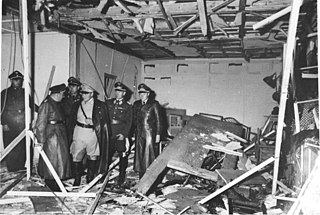
The 20 July plot was a failed attempt to assassinate Adolf Hitler, the chancellor and leader of Nazi Germany, and subsequently overthrow the Nazi regime on 20 July 1944. The plotters were part of the German resistance, mainly composed of Wehrmacht officers. The leader of the conspiracy, Claus von Stauffenberg, planned to kill Hitler by detonating an explosive hidden in a briefcase. However, due to the location of the bomb at the time of detonation, the blast only dealt Hitler minor injuries. The planners' subsequent coup attempt also failed and resulted in a purge of the Wehrmacht.

Job Wilhelm Georg Erdmann Erwin von Witzleben was a German Generalfeldmarschall in the Wehrmacht during the Second World War. A leading conspirator in the 20 July plot to assassinate Adolf Hitler, he was designated to become Commander-in-Chief of the Wehrmacht in a post-Nazi regime had the plot succeeded.
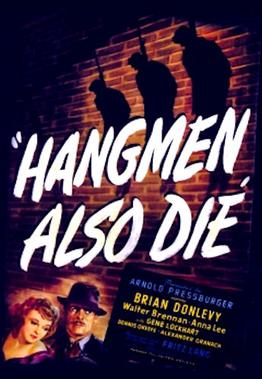
Hangmen Also Die! is a 1943 noir war film directed by the Austrian director Fritz Lang and written by John Wexley from a story by Bertolt Brecht and Lang. The film stars Hans Heinrich von Twardowski, Brian Donlevy, Walter Brennan, Alexander Granach and Anna Lee, and features Gene Lockhart and Dennis O'Keefe. Hanns Eisler composed the score, being nominated for an Academy Award, and the cinematographer was James Wong Howe.
The Schwarze Kapelle was a term used by the Gestapo to refer to a group of conspirators in Nazi Germany, including many senior officers in the Wehrmacht, who plotted to overthrow Adolf Hitler. Unlike the Rote Kapelle, the name given by the Gestapo to the Soviet spy network in the Third Reich, many members of the Black Orchestra were of aristocratic background, felt contempt for the ideology of the Nazi Party, and were politically close to the Western Allies.

The People's Court was a Sondergericht of Nazi Germany, set up outside the operations of the constitutional frame of law. Its headquarters were originally located in the former Prussian House of Lords in Berlin, later moved to the former Königliches Wilhelms-Gymnasium at Bellevuestrasse 15 in Potsdamer Platz.

Kurt Gebhard Adolf Philipp Freiherr von Hammerstein-Equord was a German general (Generaloberst) who was the Commander-in-Chief of the Reichswehr, the Weimar Republic's armed forces. He is regarded as "an undisguised opponent" of Adolf Hitler and the Nazi regime.

Albrecht Mertz von Quirnheim was a German Army colonel and a resistance fighter in Nazi Germany involved in the 20 July plot against Adolf Hitler.
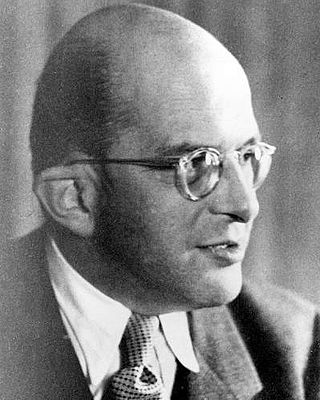
Erwin Planck was a German politician, and a resistance fighter against the Nazi regime.

Hans von Dohnanyi was a German jurist. He used his position in the Abwehr to help Jews escape Germany, worked with German resistance against the Nazi régime, and after the failed 20 July Plot, he was accused of being the "spiritual leader" of the conspiracy to assassinate Hitler, and executed by the SS in 1945.
Alexander Schmorell was a Russian-German student at Munich University who, with five others, formed a resistance group known as White Rose which was active against the Nazi German regime from June 1942 to February 1943. In 2012, he was glorified as a saint and passion bearer by the Russian Orthodox Church Outside Russia, and is venerated by Orthodox Christians throughout the world.
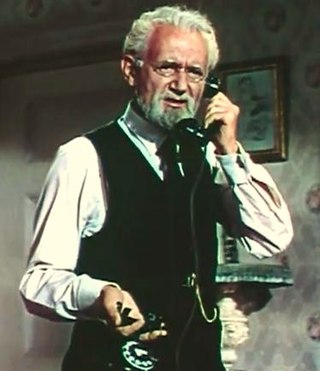
Ludwig Donath, was an Austrian actor who appeared in many American films.
Hans Heinrich von Twardowski was a German film actor.

The government of Nazi Germany was a totalitarian dictatorship governed by Adolf Hitler and the Nazi Party according to the Führerprinzip. Nazi Germany was established in January 1933 with the appointment of Adolf Hitler as Chancellor of Germany, followed by suspension of basic rights with the Reichstag Fire Decree and the Enabling Act which gave Hitler's regime the power to pass and enforce laws without the involvement of the Reichstag or German president, and de facto ended with Germany's surrender in World War II on 8 May 1945 and de jure ended with the Berlin Declaration on 5 June 1945.
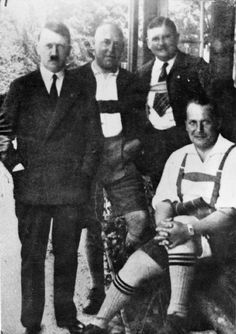
The Night of the Long Knives was a purge in which Adolf Hitler and the regime of Nazi Germany targeted members of the Sturmabteilung (SA), the paramilitary wing of the Nazi Party, as well as past opponents of the party. At least 85 people were murdered in the purge, which took place between June 30 and July 2, 1934.
Speer und Er is a three-part German docudrama starring Sebastian Koch as Albert Speer and Tobias Moretti as Adolf Hitler. It mixes historical film material with reconstructions, as well as interviews with three of Speer's children, Albert Speer Jr., Arnold Speer and Hilde Schramm.

Josef Albert Meisinger, also known as the "Butcher of Warsaw", was an SS functionary in Nazi Germany. He held a position in the Gestapo and was a member of the Nazi Party. During the early phases of World War II Meisinger served as commander of Einsatzgruppe IV in Poland. From 1941 to 1945 he worked as liaison for the Gestapo at the German embassy in Tokyo. He was arrested in Japan in 1945, convicted of war crimes and was executed in Warsaw, Poland.
The Hitler Gang is a 1944 American pseudo-documentary film directed by John Farrow, which traces the political rise of Adolf Hitler. Described as a "documentary-propaganda" film by its studio, Paramount Pictures, the historical drama is based on documented fact and marks the first serious effort to portray Hitler in film. The filmmakers chose to avoid casting stars in the lead roles, assembling instead a remarkable company of lookalikes to play Hitler, Goebbels, Himmler, Göring, and other leading Nazis.

Franz Josef Huber was an SS functionary who was a police and security service official in both the Weimar Republic and Nazi Germany. Huber joined the Nazi Party in 1937 and worked closely with Gestapo chief Heinrich Müller. After the German annexation of Austria in 1938, Huber was posted to Vienna, where he was appointed chief of the Security Police (SiPo) and Gestapo for Vienna, the "Lower Danube" and "Upper Danube" regions. He was responsible for mass deportations of Jews from the area. After the war ended, Huber never served any prison time. He was employed by the West German Federal Intelligence Service from 1955–64. He died in Munich in 1975.
The Bavarian Political Police, BPP, was a police force in the German state of Bavaria, active from 1933 to 1936. It served as a forerunner of the Gestapo in Bavaria, the secret police during the Nazi era, and was predominantly engaged in the persecution of political opponents of the Nazis.